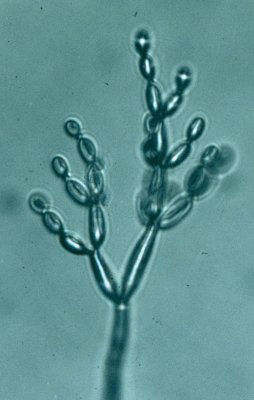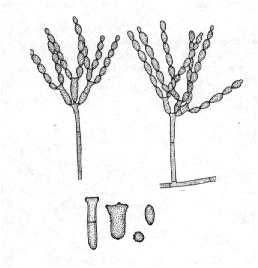Main page <> Index of descriptions <> Previous description <> Cladosporium <> Next description
Cladosporium


Colonies dark greenish to black, black in reverse, and relatively slow-growing. The dark spores are 1- or 2-celled and occur in long, branching chains that arise from a dark conidiophore. The youngest spore is at the top of the chain. The slightest movement will disrupt the chains, making microscope mounts of the whole structure nearly impossible. The best way to recognize the genus is by the prominent scars on the spores where the adjacent ones were attached. Very common on decaying plants and fungi; the fungus most commonly isolated from air, both indoors and outdoors.
It has always been difficult to identify species of Cladosporium. Most isolates from air and from habitats associated with humans have been referred to one of three species, distinguished by the following key:
1. Spores usually ellipsoidal in shape, only rarely spherical - 2
1. Spores often nearly spherical - C. sphaerospermum
2. Spores smooth - C. cladosporioides
2. Spores warty - C. herbarum
Classification: Davidiellaceae (Capnodiales). Holomorph: Davidiella, Mycosphaerella and Venturia. Ref: Bensch et al., 2012; Crous et al, 2007; Ellis 1971, 1976; de Vries 1952; Wang, 1990